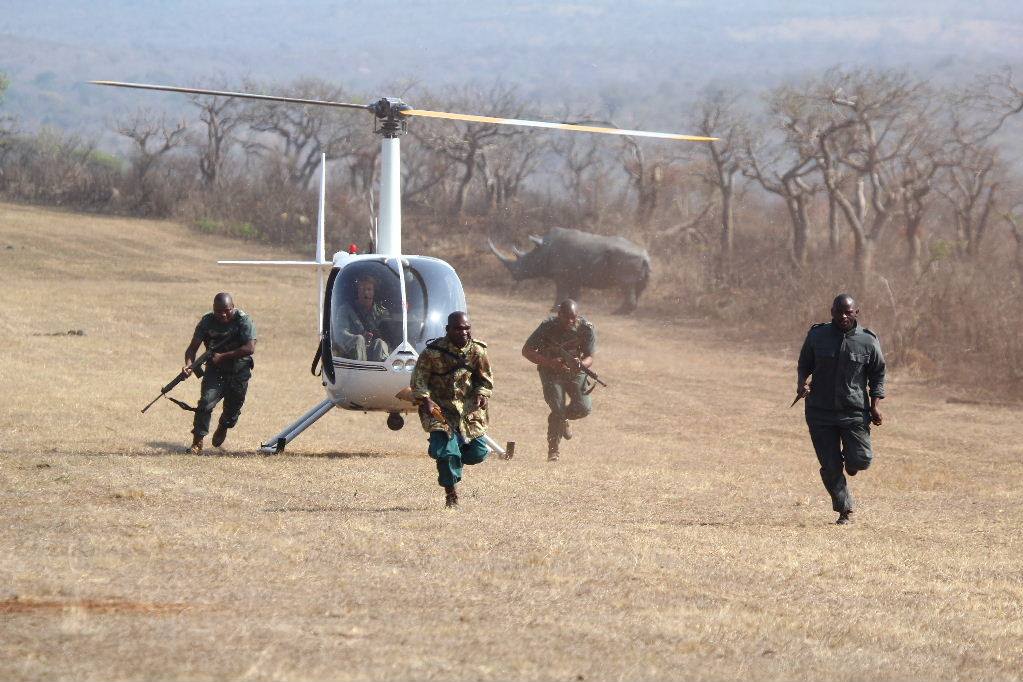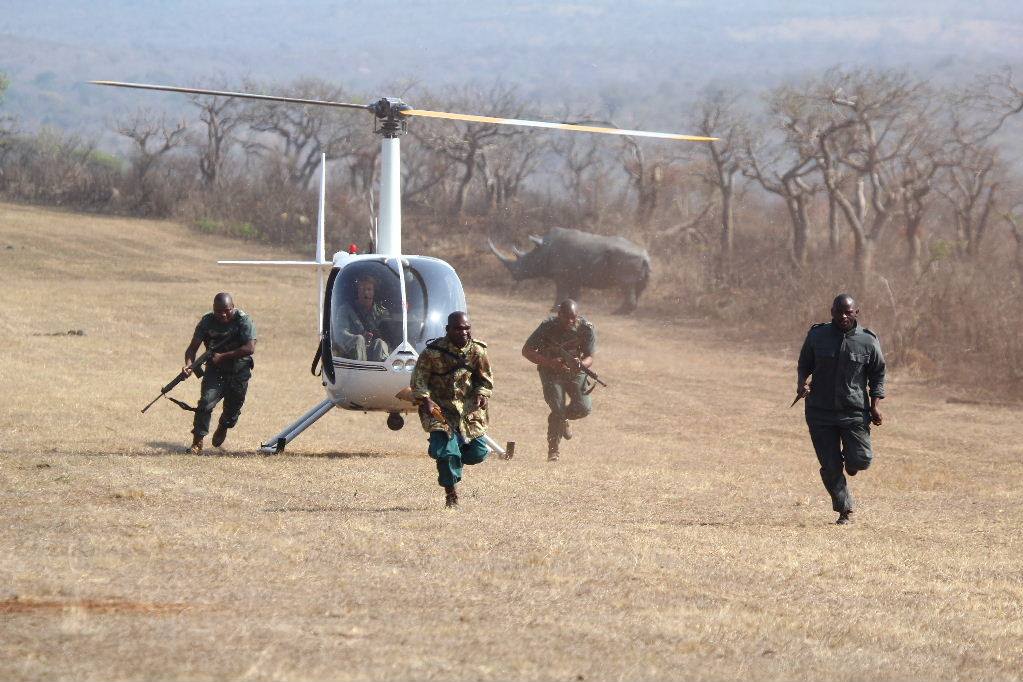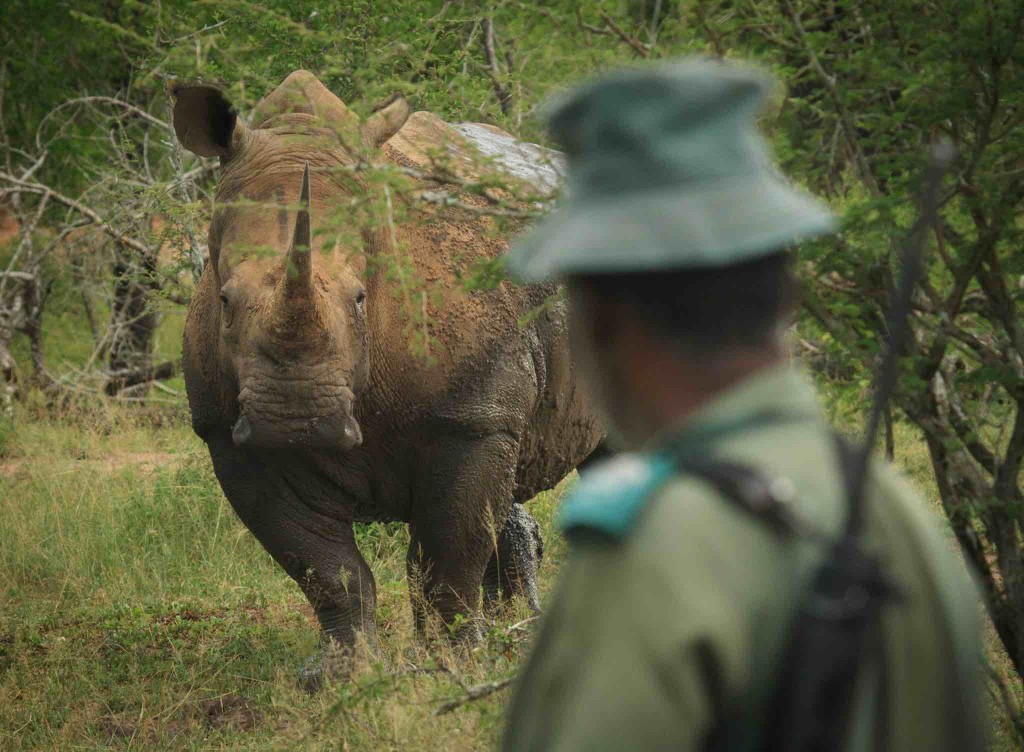
02 Sep SADC backs ‘shoot to kill’ strategy
SADC report reveals how member states favour an anti-poaching strategy with far-reaching consequences for the independence of national judiciaries, writes Lawrence Seretse

An anti-poaching simulation in Hluhluwe-iMfolozi Park in 2014. The SADC report raises various concerns about the escalating killing of wildlife in Southern Africa
The Southern African Development Community (SADC) ministers responsible for environment and natural resources adopted the Botswana position on taking the war to the poachers’ doorstep in a report titled Law Enforcement and Anti-Poaching Strategy 2016-2021.
The SADC was expected to take a final position on the strategy ahead of the coming CITES COP17 summit in Johannesburg this September. But Botswana snubbed an SADC meeting on August 5 where the policy would have been finalised because of disagreements with neighbouring countries about how its natural resources should be managed.
In the report, the SADC secretariat pens a multi-pronged strategy on wildlife poaching that is being criticised for promoting judicial interference and undermining court processes through laws that seek to force courts to give mandatory maximum penalties for poaching offences.
The secretariat raises various issues of concern regarding the escalating killing of wildlife in Southern Africa and the illegal trade fuelled by what they term as poor judicial processes, porous borders, corruption and the rising poverty in communities.
A year ago Botswana’s Minister of Wildlife and Tourism, Tshekedi Khama, came under scrutiny for his undocumented “shoot to kill” policy on poachers which was reported as likely to spark diplomatic tensions with neighbours, especially in Namibia where suspected poachers where shot and killed by the Botswana army.
Khama is quoted in the SADC report stating that the region’s commitment should be followed up by the implementation of the SADC Law Enforcement and Anti-Poaching Strategy. In July this year Khama still maintained this robust stance, saying he would do anything it takes to protect the country’s wildlife resources and threats to security operation on patrol. (See “Shoot to kill policy is here to stay”)
In the anti-poaching strategy report, the SADC points to the fact that member countries are not adequately armed to combat poaching syndicates. It states that intelligence gathering to inform operations is the single most effective tool for law enforcement, but requires more funding and capacity so that informants can be covertly well “incentivised” from all other parts of the law enforcement teams.
The strategy favours not infiltrating poaching syndicates with security personnel, but rather to offer bribes and inducements to solicit information.
“Rangers must be confident and disciplined. Well trained and operational and adequately equipped, rationed, mobile with radio communication. Patrols require adequate arms and ammunition capable of matching that of poachers,” reads a part of the report.
As the country leading the aggressive stance on wildlife poaching, Botswana has an aggressive “shoot to kill” policy. Its strategies include arming joint operation commands and signing of operation procedures that can enable cross-border pursuit of poachers.
The SADC secretariat report states that it will develop work plans and budgets for implementation by member states following the ministerial approval of these strategies.

A ranger guards a white rhino. The rationale behind the introduction of minimum sentences for poaching is to send a strong message to poachers, but it means that presiding judicial officers’ discretion will be removed. Photo © GRAA
Judicial interference?
A Botswana human rights lawyer who did not want to be named due to intimidation by government authorities criticised the SADC strategy as seeking to promote judicial interference by its member states under the veil of combating the killing of wild animals.
In this war against poaching, he said, the SADC strategy on the enhancement of law enforcement calls for the “securing of convictions” and the inclusion of mandatory minimum penalties for poaching in member states.
The rationale behind the introduction of minimum sentences is to send a strong message to poachers, but it means that presiding judicial officers’ discretion will be removed. The strategy does not appear to address the individual constitutional differences of individual member states, he said.
“This removes the discretion of the courts to give light penalties,” states the SADC report, adding that “effective” magistrates and prosecutors, in ensuring convictions, will determine the success of the strategy.
The strategy further seeks to promote vigorous training of magistrates in order to secure convictions. Such training would be coupled with “monitoring and tracking of court cases to motivate judges and maintain a momentum of court proceedings”.
The lawyer said this demonstrated disregard for the principles of judicial autonomy and independence.
The monitoring and motivation of judges and magistrates goes “against the very tenets of an independent judiciary,” he said. “In Botswana no institution has the power to monitor judges or magistrates other than the Administration of Justice. And not even the Administration of Justice has the authority, let alone the legality to ‘motivate’ a judicial officer,” the lawyer said.
“It is appalling that such a resolution would be adopted by SADC countries in certain violation of their national constitutions.”
He also commented that in part five of the LEAP strategy, where it seeks to give senior wildlife management the authority not only to discipline but to undermine employment laws, by hiring and firing without following “lengthy bureaucratic processes”, SADC votes for what will become an infringement of employee rights.
The report states critical legal provisions are lacking to enable direct involvement of communities and trained wildlife management to support the combat against poaching.
Another part of the strategy promotes legitimisation of regional and international trade in natural resources products to achieve sustainable use.
“Appropriate strategies need to be developed, implemented and reviewed regularly in order to reduce poverty and wildlife crime, given the linkages between the two. For example, those countries with stockpiles of ivory and rhino horn and who may wish to legally trade in these products in the future need to ensure that the stockpiles are kept and managed in line with CITES resolutions.”
It is here that the SADC secretariat and Khama harmonise on one thing and disagree about the other. They both agree that poaching should be eliminated and heavily armed operatives are a necessity. Botswana, however, has taken an alternative stance to promote photographic tourism rather than the commercialisation of wildlife, such as in the instances of captive breeding and hunting.
At a press conference on August 19 2016 to raise awareness about rhino poaching and its connection to the near extinction of vultures, insiders said Khama had snubbed the SADC meeting scheduled for August 5 because he disagreed with the position taken by other countries on how Botswana should manage its resources.
The draft strategy was developed and presented to the SADC secretariat steering group for the anti-poaching strategy in March 2015. It was then presented to the technical committee on wildlife in May 2015, which recommended validation of the strategy.
The strategy was validated by a workshop of the SADC member states in August 2015. Thereafter, it was presented to and approved by the SADC ministers responsible for environment and natural resources at their meeting held in November 2015, in Gaborone, Botswana.
The SADC ministers and the ministerial committee of the organ on politics, defence and security cooperation should have taken a final position on the LEAP strategy ahead of the CITES COP17 summit in Johannesburg.
According to the CITES Monitoring the Killing of Elephants (MIKE) census, the number of elephants killed in Africa is in the range of 14,000 to 17,000 a year out of the population of approximately 650,000.
“SADC member states support the largest population in Africa totalling to 495 000,” the census says, “while rhino poaching has increased dramatically from 13 in 2007 to 1,215 in 2014.”
Lawrence Seretse is an Oxpeckers Associate based in Botswana, and a finalist in the CNN African Journalist of the Year Awards. This article first appeared in The Botswana Gazette
Read the SADC Law and Anti-Poaching Strategy 2016-2021 here
Related investigations:
• Botswana bans canned hunts
• Officials turn a blind eye to smuggling of wild lions
